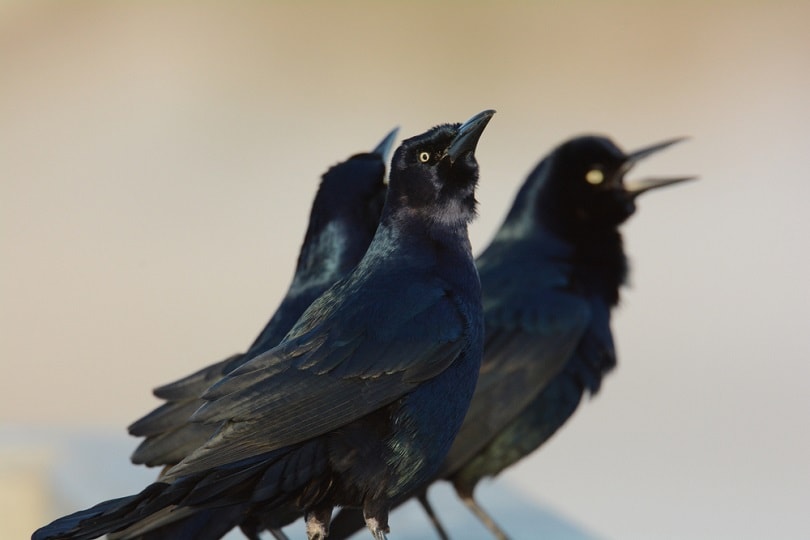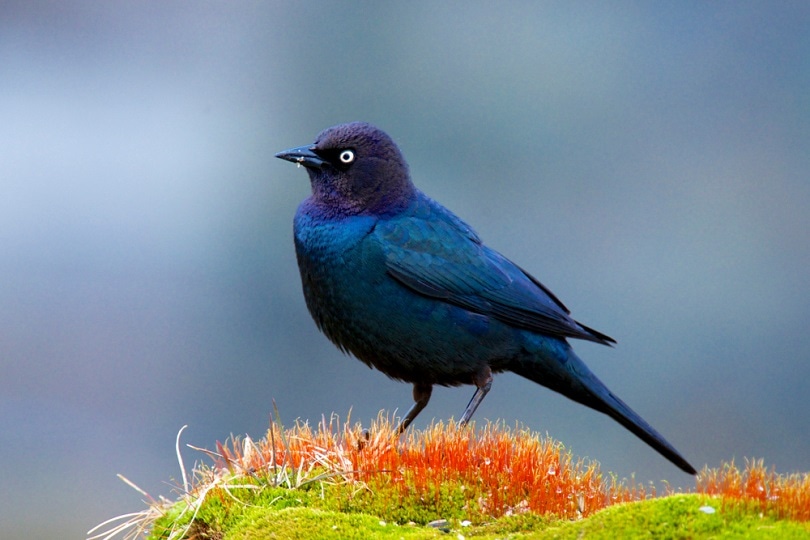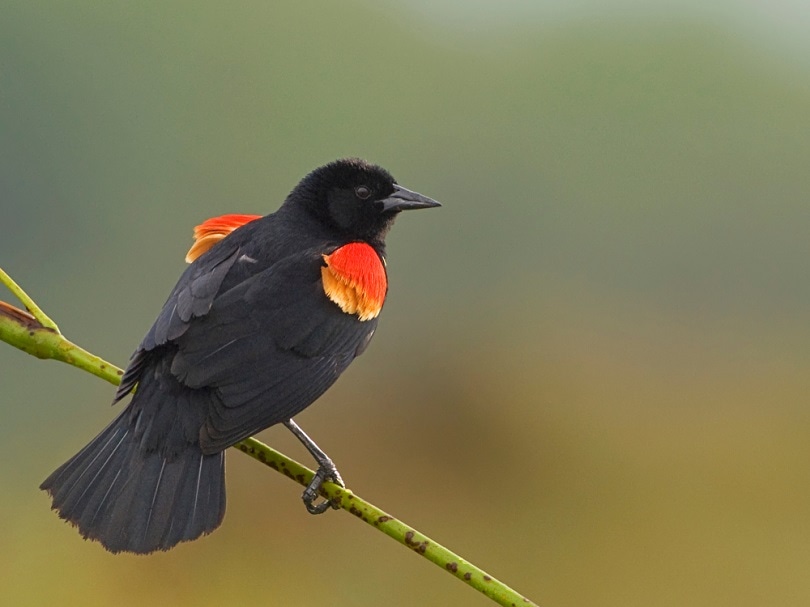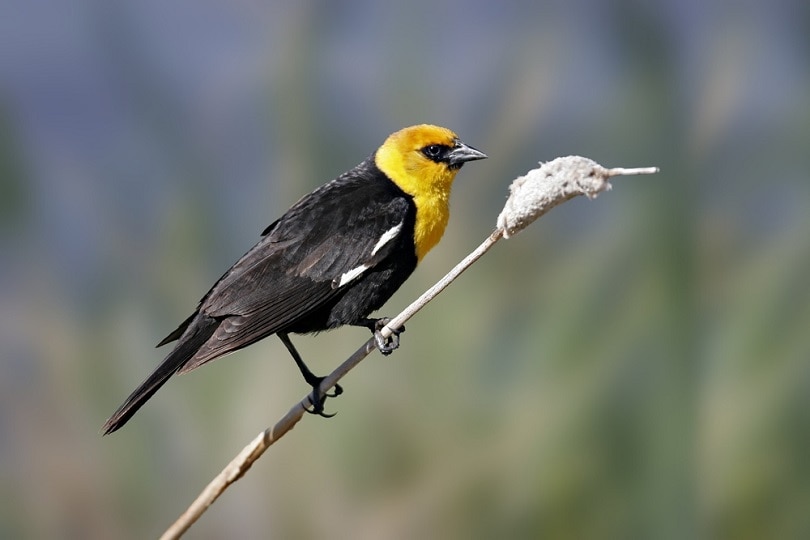5 Types of Black Bird Species (With Pictures)
Last Updated on

We don’t know if you’ve heard this, but in some cultures, the blackbird comes with a spirit. And that spirit could either be good, or bad. Apparently, owing to the fact that this species has dark wings, people in those cultures believe it can travel between worlds, and interact with different mysteries that often haunt the human soul. In other words, they’re capable of accessing the spirit realm, and interacting with lost souls.
Is there even just an iota of truth in that belief? We don’t know! All we know is, we love birds, and we love learning about them. And the first black bird that we’ll be discussing today is the…

5 Types of Black Bird Species
1. Boat-Tailed Grackle

You know how people usually say that one could easily mistake a bird for an angel because of how well it sings? Well, you’ll have to be deaf to mistake this one for anything. The Boat-Tailed Grackle probably has the worst voice on planet earth. We’re not trying to sound dramatic, but the minute you hear those chaak-chaak-chaak kweet-kweet trills and squeaks, you just feel compelled to run to the store, so that you can get yourself a noise-cancelling headphone.
If you’re interested in seeing them, you’ll have to look for an open coastal area or salt marshes. Those are their preferred habitat. They are very common around such areas, and never migrate even during winter.
The Boat-Tailed Grackle is not the type of bird that will scare easily. Of course, they’ll fly away if you start chasing after them, but they’ll stay, if they see you as a comrade. While searching for food, they’ll hang around with humans at the beaches, in the parking lot, or by the roadside.
And that’s the reason why they’ll hang around humans in parking lots, beaches, or by the roadside, while searching for food.
Its diet comprises lizards, frogs, mollusks, turtles, and insects. During winter, a time when food sources are limited, they’ll scavenge food from pets, humans, and sometimes consume fruits.
Oh, and here’s a fun fact: The bird likes to hold its tail while flying, making it look like the keel of a boat. Hence, the name Boat-Tailed.
| Color: | Male are glossy black, Females are dark brown |
| Shape: | Large, lanky with rounded crowns |
Both Sexes
| Length: | 10.2-14.6 in (26-37 cm) |
| Weight: | 3.3-8.4 oz (93-239 g) |
| Wingspan: | 15.3-19.7 in (39-50 cm) |
2. Brewer’s Blackbird

The first thing that comes to mind whenever we hear someone talk about the Brewer’s Blackbird, is an agricultural field. That’s because this species likes to hang out in such places, especially if they’ve got brushy edges. If there are no agricultural fields in your area, try the campgrounds, parks, grazing areas, or wetlands.
During breeding season, they’ll isolate themselves in pairs. And that’s not surprising at all considering most blackbirds do. The other thing that we found to be typical of this species was the fact that it loves forming flocks with other species. So, obviously, they are more social in nature.
You can definitely tell we studied them a lot, and learned many great things. For example, we also realized they’re always drawn to farm machinery. You’ll see them flying around the equipment even if it’s stationery because they associate it to food—The food that they usually get during plowing.
What do they love eating? They’re into waste grains, berries of any kind, seeds, and insects.
The Brewer’s Blackbird is a monogamous bird, and it prefers nesting in loose colonies. The female will use weeds, grass, twigs, hair, and rootlets to build a bulky nest on top of a tree, or on the ground. And to ensure the base is firm enough, she’ll plaster it with the help of manure or mud.
Because the Brewer’s Blackbird thrives in human-altered habitats, their populations have increased over the years. It’s safe to assume this species is not going anywhere any time soon.
| Color: | Males are glossy black, Females are planer brown |
| Shape: | Long-legged and well-proportioned |
Female
| Length: | 7.9-8.7 in (20-22 cm) |
| Weight: | 1.8-2.4 oz (50-67 g) |
| Wingspan: | 14.6 in (37 cm) |
Male
| Length: | 8.3-9.8 in (21-25 cm) |
| Weight: | 2.1-3.0 oz (60-86 g) |
| Wingspan: | 14.6 in (37 cm) |
3. European Starling

The starlings are one of the most energetic birds on this planet. And they can be really aggressive, especially if you’re trying to interrupt their feeding time, or messing around with their nests.
During breeding season, they’ll isolate themselves, and only hang out in pairs. When they are not breeding, they’re part of an incredibly large roosting flock that also includes other blackbird species.
Ornithologists love to use the words “opportunistic and omnivorous” when describing the dieting and feeding habits of the European Starling. ‘Omnivorous’ because they eat animal-based and plant-based foods, and ‘Opportunistic’ because they’ll sometimes sample kitchen scraps.
Even though the European Starling isn’t considered endangered, it’s been reported that in some areas, their populations are dropping drastically. But the good news is, while the numbers are dropping in those areas, they keep rising in other areas. Thus, making us believe the overall range might be shifting.
| Color: | Black at a distance, but purplish-green iridescent with yellow beaks |
| Shape: | Chunky, short tails and long, slender beaks |
Both Sexes
| Length: | 7.9-9.1 in (20-23 cm) |
| Weight: | 2.1-3.4 oz (60-96 g) |
| Wingspan: | 12.2-15.8 in (31-40 cm) |
4. Red-Winged Blackbird

Identifying the Red-Winged Blackbird shouldn’t be a problem, unless you’re trying to identify a female. First off, they’ve been aptly named after their most distinctive feature—the red wing. There’s nothing else to explain there, as it’s straightforward.
Now, the reason why we keep saying discerning the female Red-Winged Blackbird will be problematic—even to the most experienced birders out there—is because they do resemble marsh-loving sparrows.
- Shoulders: Just move closer to the bird. Not too close, or you’ll spook it. Maintain some distance. If you see some tinge or rust on the upperparts and shoulders of the species, it might be a female Red-Winged Blackbird. We’re saying “might” because you still have to look for the other distinguishing features. And by the way, the females don’t have the bold scapulars. Only the male Red-Winged Blackbird do.
- Facial marks: The face will always have dark malar stripes, an eye line, and a pale eyebrow.
- Bill: The bill is similar to that of the male Red-Winged Blackbird. It’s sharp, triangular, and black.
The Red-Winged Blackbird will only live in an area that has cattails in abundance. Cattails are their primary nesting materials, so they’ll never compromise on it. If we’re talking about the diet, 75 percent is seeds, and that remaining fraction is made up of caddisflies, mayflies, and dragonflies.
They breed colonially, but that’s because they really don’t have any other choice. We noted that their habitats are patchy, and have been for a while now, due human interference.
Are they monogamous? Nope. These birds believe in the sister-wives way of living. In fact, the male Red-winged Blackbird can mate with more than 10 females in a single breeding season.
The Red-Winged Blackbird is not an endangered species. And to tell you the truth, these birds are like roaches. They’ll survive no matter what you do to them because they know how to quickly adapt to changes in the environment.
| Color: | Glossy black, red-and-yellow shoulder badges |
| Shape: | Stocky, broad-shouldered |
Both Sexes
| Length: | 6.7-9.1 in (17-23 cm) |
| Weight: | 1.1-2.7 oz (32-77 g) |
| Wingspan: | 12.2-15.8 in (31-40 cm) |
5. Yellow-Headed Blackbird

This species is common around the Mississippi River. You’ve probably noticed their population drastically increases during summer in the west-central regions of the country, and drops dramatically during winter. That’s because they normally migrate to the western regions during those cold months to search for more food.
The Yellow-Headed Blackbird is omnivorous. So don’t act surprised, if you find them foraging on the ground searching for spiders, nuts, grains, seeds, or grasshoppers. The seeds will be their main diet during winter and the insects during summer.
The wetlands usually provide suitable sites for breeding. The male Yellow-Headed Blackbird will first establish a territory, and then start singing so as to attract multiple females. That’s right! They are polygamous as well.
Their populations have been steady for a while, but we recently found out that they’ve been dropping once more on the eastern parts. Investigations were done, and the findings were not shocking at all.
Looks like farmers in those areas never got the memo, as they’re still using pesticides made of chemicals known to affect the overall health of different bird species. We couldn’t tell if it was out of ignorance or they didn’t just care, but something had to be done.
| Color: | Yellow heads and chests |
| Shape: | Stout body, a large head |
Both Sexes
| Length: | 8.3-10.2 in (21-26 cm) |
| Weight: | 1.6-3.5 oz (44-100 g) |
| Wingspan: | 16.5-17.3 in (42-44 cm) |

Conclusion
In case you didn’t know, birding is actually a popular hobby. So if there’s any chance you’re interested in learning about these birds, just join a club or group, there are probably several in your area. These creatures are beautiful, and the only way we’ll save them from extinction is through education. Sign up for a class, and share the knowledge gained with your friends.
You might also be interested in:
- Male vs. Female Red-tailed Hawks: Spotting the Differences
- Golden Eagle vs. Bald Eagle: What’s the Difference?
Featured Image Credit: Gilbert S. Grant, Shutterstock
About the Author Robert Sparks
Robert’s obsession with all things optical started early in life, when his optician father would bring home prototypes for Robert to play with. Nowadays, Robert is dedicated to helping others find the right optics for their needs. His hobbies include astronomy, astrophysics, and model building. Originally from Newark, NJ, he resides in Santa Fe, New Mexico, where the nighttime skies are filled with glittering stars.
Related Articles:
Monocular vs Telescope: Differences Explained (With Pictures)
How to Clean a Refractor Telescope: Step-by-Step Guide
How to Clean a Telescope Eyepiece: Step-by-Step Guide
How to Clean a Rifle Scope: 8 Expert Tips
What Is a Monocular Used For? 8 Common Functions
How to Clean a Telescope Mirror: 8 Expert Tips
Brightfield vs Phase Contrast Microscopy: The Differences Explained
SkyCamHD Drone Review: Pros, Cons, FAQ, & Verdict
